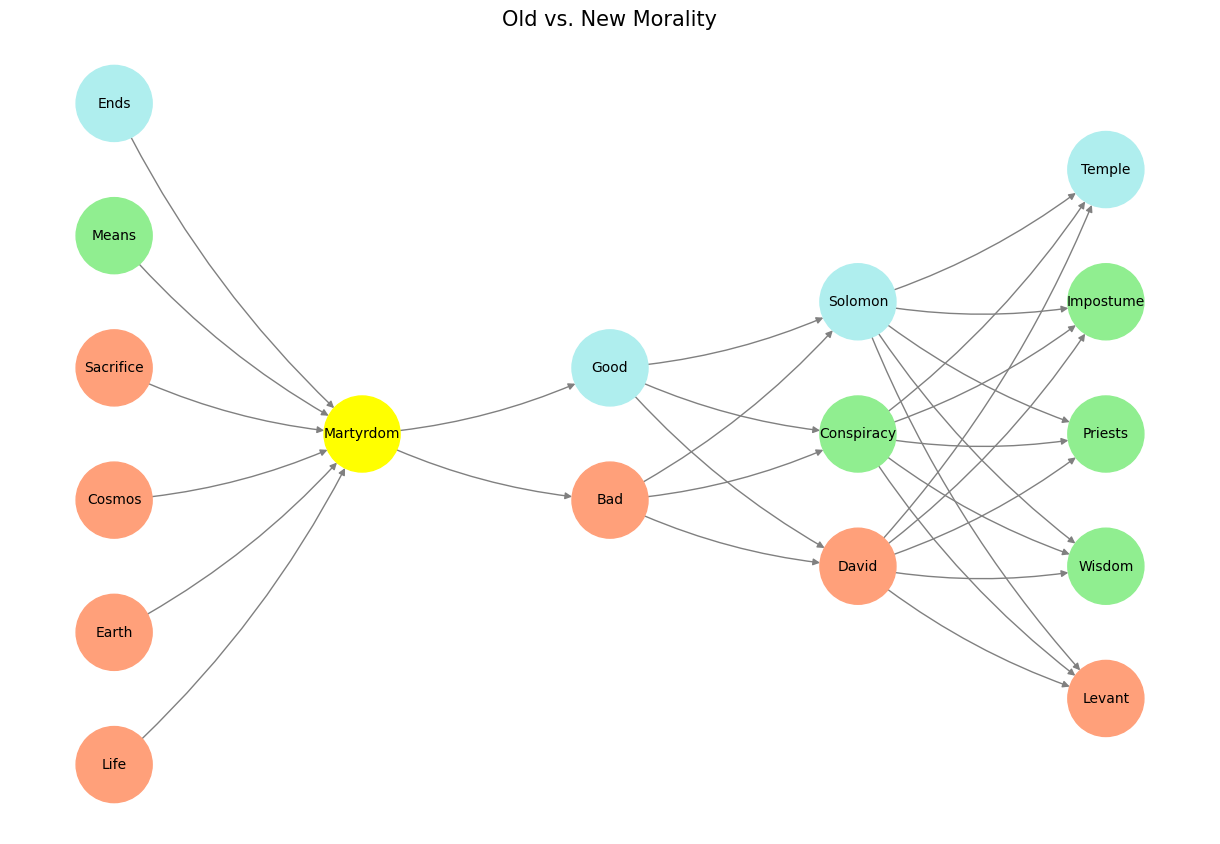Catalysts#
The Misunderstood Significance of Language in Human Evolution and Intelligence#
At minute 7:00 of the discussion, a claim was made that human beings over-value language. The speaker argued that while the brain has dedicated structures for vision, smell, hearing, and taste, there is no specific structure for language because it is relatively new in human evolution. This assertion, though superficially provocative, reveals a fundamental misunderstanding of language’s role in human biology and intelligence. It dismisses what professionals in neural science consider common knowledge: language is not just an evolutionary novelty but a cornerstone of human intelligence.
Fig. 4 Art is Simulation 🩸. Creates the illusion of a vast combinatorial space wherein the protagonist may take this and that path by freewill. The output layer is happiness, but the labyrinth must be exploredl You must explore your Ids, your happiness, and more through art. Source: DKK#
Language, like DNA, is an inheritance system, encoding and transmitting information critical to survival and social functioning. While DNA encodes biological processes—such as feeding and breeding, wakefulness and sleep, fight and flight—language serves a parallel role in the social domain. It encodes cooperative, transactional, and adversarial processes that enable humans to adapt and thrive in complex societies. To trivialize language as lacking structure is to overlook the integrated systems in the brain that support it, such as Broca’s and Wernicke’s areas, which coordinate the production and comprehension of speech, as well as the neural networks that connect them to motor, sensory, and cognitive functions.
The speaker’s claim that language lacks a dedicated brain structure reflects a misunderstanding of how the human brain evolved to repurpose and integrate existing systems for new functions. While it is true that language is a relatively recent evolutionary development, it is precisely this recency that underscores its significance. Language is a symbolic system that amplifies intelligence by encoding abstract ideas, facilitating communication, and enabling cultural transmission. It has been pivotal in the development of cooperative societies, technological innovation, and moral frameworks.
To frame language as central to intelligence, one must recognize its role as an inherited system of symbols that parallels DNA in its impact. Language encodes social processes just as DNA encodes biological ones. Social processes include:
Cooperation: Establishing norms and enabling collective action.
Transaction: Facilitating trade, reciprocity, and resource exchange.
Adversarial Negotiation: Resolving conflicts and managing competition.
Through these mechanisms, language becomes more than a tool for communication; it is a dynamic system that shapes human cognition, relationships, and societal evolution.
A Framework for Understanding Intelligence and Language#
To better contextualize language’s role, consider its place within an artificial intelligence (AI) framework. This perspective highlights how natural systems like DNA and language serve as foundational constructs for intelligence:
World Rules:
Natural rules, encoded by DNA, govern biological processes.
Social rules, encoded by language, reflect evolving moralities (e.g., the tension between old and new moral systems).
Perspective AI:
Intelligence requires balancing instinctual responses with deliberative thought, akin to how humans balance reflexes with reason.
Agentic AI:
Just as intelligence mediates between authority and autonomy, language encodes ethical distinctions between good and evil.
Generative AI:
Language opens vast combinatorial spaces for creativity, analogous to how tribes historically navigated complex decisions in uncertain environments.
Physical AI:
Emotion, a physical manifestation of intelligence, optimizes responses to environmental and social stimuli, much like language optimizes human interaction and decision-making.
The Danger of Oversimplification#
The argument dismissing language’s biological roots and evolutionary significance reflects a broader issue in interdisciplinary conversations: oversimplification. Language is not merely an add-on to human cognition; it is deeply embedded in our biology, culture, and intelligence. To dismiss it as lacking structure is to overlook its profound impact on the evolution of human societies and its parallels with fundamental biological processes.
Professionals must address such oversights to ensure that discussions about intelligence—whether biological or artificial—remain grounded in robust scientific and philosophical understanding. Language is not just intelligence expressed; it is intelligence encoded, enabling humans to navigate the complexities of existence, from moral dilemmas to technological advancements.
In essence, language is the DNA of human social evolution, and its dismissal is a disservice to the understanding of both human nature and the systems that define intelligence.
Show code cell source
import numpy as np
import matplotlib.pyplot as plt
import networkx as nx
# Define the neural network structure; modified to align with "Aprés Moi, Le Déluge" (i.e. Je suis AlexNet)
def define_layers():
return {
'Pre-Input/CudAlexnet': ['Life', 'Earth', 'Cosmos', 'Sacrifice', 'Means', 'Ends'],
'Yellowstone/SensoryAI': ['Martyrdom'],
'Input/AgenticAI': ['Bad', 'Good'],
'Hidden/GenerativeAI': ['David', 'Conspiracy', 'Solomon'],
'Output/PhysicalAI': ['Levant', 'Wisdom', 'Priests', 'Impostume', 'Temple']
}
# Assign colors to nodes
def assign_colors(node, layer):
if node == 'Martyrdom':
return 'yellow'
if layer == 'Pre-Input/CudAlexnet' and node in [ 'Ends']:
return 'paleturquoise'
if layer == 'Pre-Input/CudAlexnet' and node in [ 'Means']:
return 'lightgreen'
elif layer == 'Input/AgenticAI' and node == 'Good':
return 'paleturquoise'
elif layer == 'Hidden/GenerativeAI':
if node == 'Solomon':
return 'paleturquoise'
elif node == 'Conspiracy':
return 'lightgreen'
elif node == 'David':
return 'lightsalmon'
elif layer == 'Output/PhysicalAI':
if node == 'Temple':
return 'paleturquoise'
elif node in ['Impostume', 'Priests', 'Wisdom']:
return 'lightgreen'
elif node == 'Levant':
return 'lightsalmon'
return 'lightsalmon' # Default color
# Calculate positions for nodes
def calculate_positions(layer, center_x, offset):
layer_size = len(layer)
start_y = -(layer_size - 1) / 2 # Center the layer vertically
return [(center_x + offset, start_y + i) for i in range(layer_size)]
# Create and visualize the neural network graph
def visualize_nn():
layers = define_layers()
G = nx.DiGraph()
pos = {}
node_colors = []
center_x = 0 # Align nodes horizontally
# Add nodes and assign positions
for i, (layer_name, nodes) in enumerate(layers.items()):
y_positions = calculate_positions(nodes, center_x, offset=-len(layers) + i + 1)
for node, position in zip(nodes, y_positions):
G.add_node(node, layer=layer_name)
pos[node] = position
node_colors.append(assign_colors(node, layer_name))
# Add edges (without weights)
for layer_pair in [
('Pre-Input/CudAlexnet', 'Yellowstone/SensoryAI'), ('Yellowstone/SensoryAI', 'Input/AgenticAI'), ('Input/AgenticAI', 'Hidden/GenerativeAI'), ('Hidden/GenerativeAI', 'Output/PhysicalAI')
]:
source_layer, target_layer = layer_pair
for source in layers[source_layer]:
for target in layers[target_layer]:
G.add_edge(source, target)
# Draw the graph
plt.figure(figsize=(12, 8))
nx.draw(
G, pos, with_labels=True, node_color=node_colors, edge_color='gray',
node_size=3000, font_size=10, connectionstyle="arc3,rad=0.1"
)
plt.title("Old vs. New Morality", fontsize=15)
plt.show()
# Run the visualization
visualize_nn()


Fig. 5 Common Fate. Socrates, Caesar, Jesus - They usurped the old morality and introduced a new one. In doing so, they became martyrs and have since been venerated by the newer priestly, ascetic morality. War is sin, period!#

